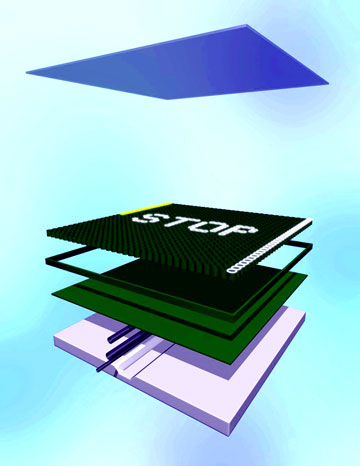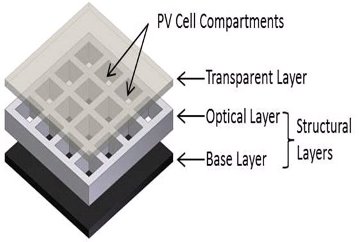Solar Roads
Anuradha S. Tanksali M.Tech (Env)
Mudassirkhan A. Pathan B.E (Civil)
Abstract
Civilized society is completely dependent on fossil fuels for nearly every aspect of its existence. While fossil fuels have been integral part in the development of most industrial nations, there are a few realities of using them that society needs to come to terms with. There are many arguments in favour of society's need for renewable energy.
Whether we think that there are hundreds of years or just a few decades left of natural resources, the fact remains that it is a finite resource. At some point, fossil fuels are going to vanish or they are going to become too expensive and we will be forced to use renewable energies.
Though this shifting works well in theory, the reality is that shifting from fossil fuels is not so easy as it is the most convenient energy source. We can't just "stop using" fossil fuels over night or even when they become too expensive but we can try and replace some part of it before it gets exhausted.
Sustainable solutions with modern design, creativity and new ideas embedded with traditional practices can reduce the dependency on natural resources for everything from energy generation to transportation infrastructure. One such example is solar road, a functioning solar photovoltaic panel.
The idea behind solar road is quite simple. In a tropical country like India, road surfaces are exposed to a vast amount of solar radiation throughout the day. Extraction of a portion of this energy can solve energy issues.
In this paper we have made an attempt to understand the feasibility of implementing solar roads in our country. This concept is already under trial in some countries and thoughts are floating even in Indian state like Gujarat. To practically implement these new ideas, we require awareness and popularisation of the concept. This is our small effort towards it.
Introduction
Rightly stated by a visionary Engineer, R. Buckminster Fuller1
"There's no energy shortage, there's no energy crisis, there's a crisis of ignorance"
Dependence on fossil fuels is extended to such an extent that survival has become a question mark. Before entering the zone of potential collapse of environmental and social systems, we need to shift to the zone of maximum utilisation of renewable sources, which otherwise have not been properly aligned for maximum output. We are going through a delicate phase where sustainable technology is critical for the current engineering innovations and designs.
Electricity is one of the vital components of National and International development. Its demand is going on increasing in an unequal manner in different continents; especially the developing countries in Asia are experiencing a sudden increase. Predictions state that by 2030 the demand might increase by 66% compared to 2000 and Asian region (excluding Japan) will account for almost 40% of the growth1.
We have six important primary renewable resources i.e., Solar, Wind, Hydro, Geothermal, Biomass, Ocean and out of these, solar is the most eco-friendly and virtually unlimited source of energy. Generation of solar energy involves zero percentage of pollution and physical risk. And in the coming future with the help of advanced technologies, it is bound to replace the conventional energies. Mass productions and technical improvements will help in reducing the cost1.
Solar energy has enormous potential, much more than what has been analysed till today. According to the data stated by the German Centre of Aerospace (DLR), 2005, "One third of the planet’s landmass is covered by desert, prone to high amount of radiation. Solar radiation from 4% of world’s desert is sufficient to meet all world electrical energy requirements today". But looking at the present political developments and the speed in accepting new ideas and their implementation, this looks like a dream. By stating this, we are not taking a back step, but the idea is to begin with a small innovative step - Solar Roads.
The idea behind solar roads is quite simple. It is a series of engineered solar panels that are driven upon. Each solar panel (usually 12ft x 12 ft) is interlinked with neighbouring panels to form the Solar Roadways system. The photovoltaic (PV) panels convert sunlight to electricity.
Design Details2
Most important part of the solar roadway is the solar road panel. Each individual panel consists of three basic layers, the road surface layer, which is translucent and high strength, yet rough enough to provide traction. It is made up of textured glass and transmits the load around the solar cells. Next is the electronics layer, which contains a large array of cells. These cells contain the super or ultra caps that store the Sun’s energy for later use. Batteries are not used in solar roads, since each road panel has its own storage in the form of ultra caps. The third layer is the base plate layer which distributes the power collected from the electronics layer and also transmits the load to a pavement, sub grade, or base structure.
 |
 |
The structural design of the panel is very important. According to the detail study performed by Andrew Northmore and Dr. Susan Tighe, mono-crystalline silicon cells are best as they provide the highest power output of commonly available solar cells. Various shapes and sizes are available, out of them 125mm square cells allow a large area for exposure and a very little part of the transparent layer is cantilevered over the cell.
To increase the voltage and current generated, the strings of solar cells are connected in series. A minimum space of 25 mm is required between the cells. Between the edge cells and the casing, an additional 12.5 mm is allowed for interconnection. As per the size considered above, we have 5 cells in each direction and as a whole, 25 cells in the whole panel. The designed panel should have 0.91 m side lengths and sufficient thickness. These solar cells are accommodated in cut-outs of multi layers of ply-fibreglass sheet. Similar cut-outs are used to allow the insulated wires to deliver the electricity from the cells inside the panel to wherever required. Above these layers multiple tempered glass layers are embedded and provided, to sustain the heavy loads. The overlaid glass is cantilevered over a small section of solar cell space.
The entire solar panel is designed with several different materials and to hold them firmly, this entire setting is given a metal enclosure, which includes aluminium channel fitted around the layers, with bolts and nuts to hold the housing to the fibreglass structure. To avoid the water from entering into the panel, edge sealing and rubber interfaces are to be provided. Overall the panel might weigh 48.35 kgs.
Brighter side of Solar Roads
Based on the analysis done by Andrew Northmore we have one mile equal to 5280 feet (1609 m). Our solar road panels are 12' by 12'. Therefore, it will take 440 panels to create one mile (considering one lane, 12 feet (3.6 m) wide). Each panel is expected to produce 7600W of electricity daily, based on 15% efficiency and four hours of sunlight per day which will sum up to 3.344 MW per lane per mile. So a typical four lane highway will produce 13.376 MW per mile, based on four hours of sunlight per day, which is quite substantial. India being a tropical country can have much more hours of sunlight2.
If we are able to conceive at least some percentage of roads as solar roads, we will be in a position to enjoy following advantages;
- Intelligent secure highways that is self sustaining.
- Creation of decentralised, power grids without poles, relay stations and transformers.
- Reduction in the dependence on conventional systems like thermal and nuclear power plants which are non eco-friendly methods of generating electricity.
- Reduction in the dependence on oil and other fossil fuels.
- Cut down of greenhouse gas emissions by over 50 %.
- Creation of safer driving conditions by illumination of roads by solar power run sensors.
- Traffic management and surveillance.
- Wild life protection, by establishing sensors which indicate animals crossing the road.
- Reduction of menace of waste plastics by using non-biodegradable plastics and other wastes as the solar road substrate.
India being a developing country, still a major part of the geographical area needs to be explored in terms of road connectivity. If we try to implement these solar roads we could improve our economy with infrastructure.
Charging Electric vehicles in parking
Areas yet to be Explored
Anything to begin with has some limitations and in the same manner in solar roads establishment, we need to deal with some questions like the higher cost, glaring effect, ultimate load carrying capacity, thermal expansion & cleaning process.
The installation cost of solar roads is three times more than the conventional roads but is more durable and self sustaining. Even at 15% efficiency, the solar roads will generate 3 times the total electricity demand. Multiple tempered glass layers are embedded and provided, to sustain the heavy loads. The overlaid glass is cantilevered over a small section of solar cell space so as to avoid the collection of rain water on top surface. The top layer is textured to such a point that it provides the same traction that current asphalt roads offer, even in the rainy season. Experiments are being conducted to use Self-cleaning glass. It is a specific type of glass with a surface which keeps itself free from dirt and grime through natural process. The glass cleans itself in two stages: the photocatalytic stage of the process breaks down the organic dirt on the glass using ultraviolet in sunlight (even on overcast days) and makes the glass hydrophilic (normally glass is hydrophobic). During the following hydrophilic state, rain washes away the dirt leaving almost no streaks, because hydrophilic glass spreads the water evenly over its surface. This technique is expected to give enough results so as to maintain the solar roads in optimal working condition. Still there are some obvious obstacles such as oil spills, sandstorms, storm debris, etc and in these cases street sweepers with advanced cleaning instruments (vehicles with large rotating brushes) can maintain the roads4,5.
Present Developments in India
Gujarat Energy Research and Management Institute (GERMI) has initiated in establishing a different view of solar roads. Their proposal is to establish a roof of solar panels across the length of the roads. They are aiming at providing solar roof along four-lane 205 km long Ahmedabad-Rajkot highway and 93 km long Ahmedabad-Vadodara National highway. It is anticipated that 104 MW & 61 MW of electricity can be generated from them respectively. Gujarat Govt has initiated in forming a solar park and tried to cover the canals with solar roofs. Even some states like Rajasthan and Maharashtra, are trying to establish solar parks in barren lands.
All these attempts towards generation of solar power are wonderful, but these need to be established specifically for the purpose. In case of roads, we have multiple benefits.
Conclusion
When we talk about solar road, the idea seems to be a crazy one and looks difficult to implement. Definitely looking at the installation cost of solar roadways, which is three times the conventional roads it seems to be difficult, but the additional benefit of generating clean, renewable energy from a self-sustaining structure makes it, worth a try.
It is normal tendency of human beings to weigh the limitations first. But, if we think in a positive direction even with these limitations, we can begin with smaller changes which will lead to dawn of a new era. If all the State Governments think of initiating the solar roads in their state in the form of pilot projects, they can as well implement them by considering pedestrian paths, parking areas, city centres and small streets. We need to note that every square meter of asphalt that gets replaced with solar roadway, is a small step on the path towards independence from fossil fuels. In future these small steps might form a giant leap forward in formation of self-sustaining, eco-friendly, healthier and better world.
"Where there is a will, there is a way,
Let’s make things happen, rather than waiting things to happen,
It’s better late than never,
Let’s go Solar and Greener".
References
- Peter Meisen and Oliver Pochert, "A Study of Very Large Solar Desert Systems with the Requirements and Benefits to those Nations having High Solar Irradiation Potential", July 2006.
- A. Northmore and S. Tighe, "Developing Innovative Roads Using Solar Technologies," in CSCE 9th International Transportation Specialty Conference, Edmonton, 2012.
- Article published in "E- The Environmental Magazine".
- http://www.wikipedia.com/
- S. Brusaw, "Solar Roadways: A Real Solution," 2012. [Online]. Available: http://solarroadways.com/main.html.
About Authors
|

Anuradha.S.Tanksali
anutanksali@gmail.com
|
Anuradha Tanksali, a BE(Civil) Graduate from Bijapur and a Post graduate in Environmental Engineering from Basaveshwar Engineering College, Bagalkot, is working as Asst Professor in the College of Engineering & Tech., Bijapur. She is the recipient of Gold Medal for her academic excellence in Post graduation and her M.Tech thesis, titled “Treatment of Sugar Industry Waste Water by Up-flow Anaerobic Sludge Blanket Reactor” was adjudged as the Best M.Tech thesis at Annamalai University, Annamalai Nagar, Tamil Nadu.
Presently doing her research (Ph.D.) in “Study of Groundwater movement and its quality parameters in minor river basin using MODFLOW and GIS” under the guidance of Dr Veena Soraganvi.
Presented 5 papers at National & International Conferences, published 2 papers in International Journal of ChemTech Research.
|
Honoured as "Women Achiever" on International Women's Day of 8th March-2013 by Loins Club of Bijapur & Department of Women & Child, Bijapur, Anuradha represented as resource person for ‘Awareness of Environment’ program at District Legal Services Authority Bijapur, District Police Services Bijapur, Forest Department, Karnataka State Pollution Control Board and numerous other organisations of Bijapur.
 |
Mudassirkhan Pathan
B.E (Civil)- Raibag Polytechnic, Raibag- I/C Head of the Department.
|